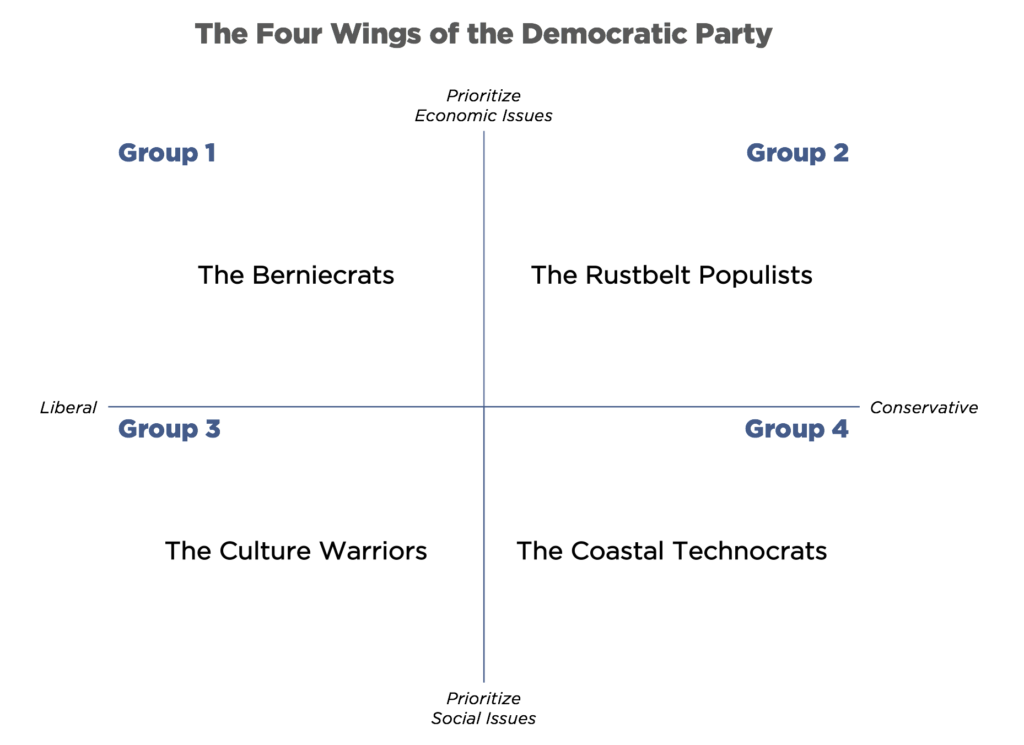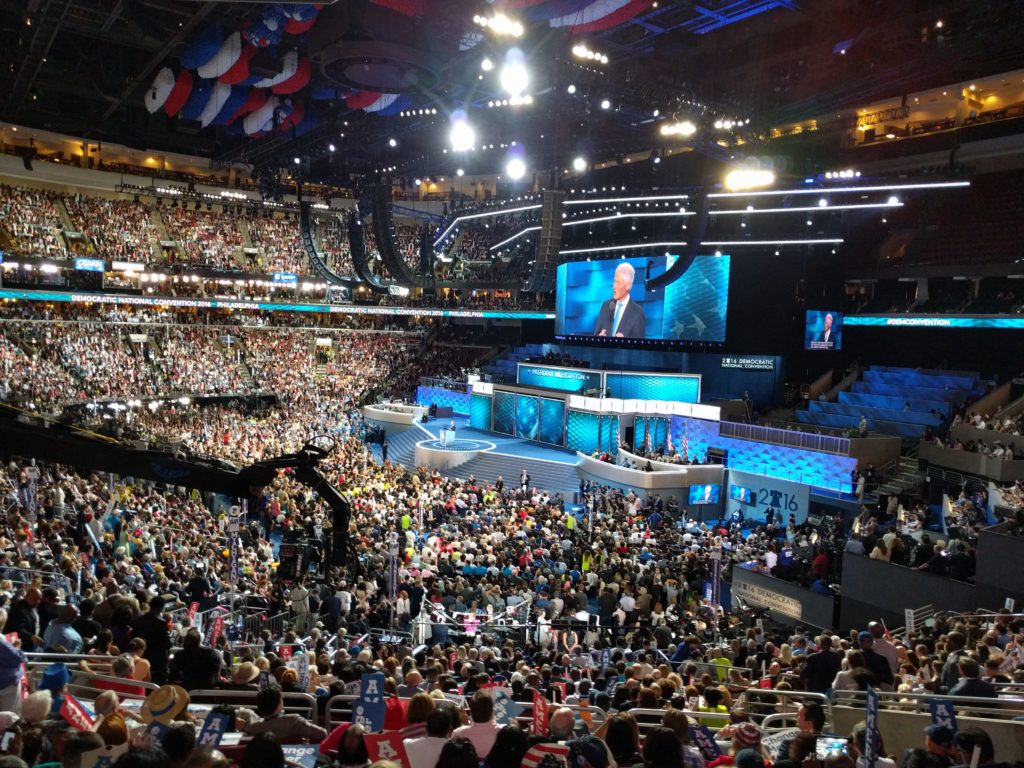There is a tendency to think Democrats are simply divided between centrists and progressives, but such thinking misses the mark. On election night 2016, one commentator explained Trump’s win, remarking, “He’s spiked the white vote… in a way that [makes] a lot of people uncomfortable but does awaken something basically that’s racial anxiety among whites… That’s been a dream on the far right.” Another commentator promptly responded, “Let me give the other version of that notion. That is that the three issues that he tapped into—trade, immigration, and wars—I think he’s on the popular side of. I think the country hates all these wars… And I think it was a legitimate campaign, on those issues.” The first speaker was the MSNBC host Rachel Maddow and the second was fellow host Chris Matthews. While Rachel Maddow suggested that Trump won because he inflamed cultural intolerance, Chris Matthews faulted Democrats for allowing Trump to take the popular side of several hot-button issues.
The events of 2016 revealed stark divisions among Democrats and ultimately demonstrated a party splintered into four wings, whose stark differences must be reconciled if it is to succeed moving forward. Because of their distinct ideologies, each offers a different reason that Hillary Clinton lost and therefore prescribes Democrats a different path forward.
In terms of voting patterns and ideology, most Democrats fall into the following four camps. These groups are divided both by the traditional liberal versus conservative axis but also by the social issue versus economic issue focused axis, as illustrated below.

The Berniecrats
The Berniecrats comprises the economically populist, progressive wing of Democrats. Berniecrats, whose ideology largely traces back to FDR and the New Deal, focus primarily on economics and are relatively more male, lower income, white, and younger than other Democrats.
As the most economically left group, Berniecrats embrace Medicare for All, a $15 minimum wage, free public college, expanded Social Security, taxes on Wall Street speculation, and a constitutional amendment to overturn Citizens United. This wing’s policies align closely with the Occupy Wall Street Movement and are in direct opposition to the business-friendly Coastal Technocrats.
Like the neighboring Culture Warriors, Berniecrats are also very pro-environment and want to work towards an emissions-free future with a total ban on fracking. And like their other neighbors, The Rust Belt Populists, Berniecrats are also skeptical of free trade deals, believing they empower corporations at the expense of workers, manufacturing jobs, and environmental regulations. In Michigan, for example, Bernie Sanders won voters who think trade takes jobs away from the US by 15 points. This group was thus strongly opposed to President Obama’s Trans-Pacific Partnership.
As the most dovish Democrats, Berniecrats opposed the Iraq War and have opposed military intervention in Syria. Perhaps most uniquely today, some are even wary of the Russia investigation, seeing it as a distraction to other issues and possibly detrimental to diplomacy. Indeed, Katrina vanden Heuvel, editor of the Nation Magazine, a progressive paper that endorsed Bernie in the 2016 democratic primaries, remarked how she was concerned about “the alliance between hawkish Democrats and neoconservatives,” and that “Russiagate has gotten out of control and the danger is that one launches a new cold war, which for Progressives is horrific.” She even added, “Russiagate has been ginned up partly by the fact that Hillary Clinton lost… and we need to work and partner with Russia on Iran.”
Though socially progressive, “Berniecrats” prioritize fighting income inequality, preferring a socially moderate but economically populist candidate above one who is socially liberal but more fiscally conservative. This was evident when the pro-Bernie Sanders organization Our Revolution endorsed the Omaha mayoral candidate Heath Mello, an economic progressive who also has a history of opposing abortion rights, while at the same time refusing to endorse pro-choice, economically moderate Jon Ossoff in Georgia.
Berniecrats tend to attribute Clinton’s loss to her neoliberal centrism, past support for free trade and to her ties to corporate America. Rather than reach out to white-collar, centrist suburban Republicans, Berniecrats seek to return the Democratic Party to its working-class roots with a firmly progressive economic agenda. Besides Bernie Sanders, Senator Jeff Merkley and Representative Tulsi Gabbard are other Berniecrats in Congress.
The Rust Belt Populists
The Rust Belt Populists is the blue collar, unionized wing of Democrats, concentrated heavily in the Midwest. Macomb County, Michigan, a white working-class suburb of Detroit, is a prominent example of a place full of these Democrats. This county is traditionally very Democratic and voted for Obama by 4 points and Democratic Senator Debbie Stabenow by 22 points in 2012, yet these same voters backed Donald Trump by 12 points in 2016. Columbia political science professor Mark Lilla is from there, and explaining its longtime Democratic loyalties, he said “It wouldn’t have even occurred to these voters to question this. The history of unionization was so strong”.
Indeed, The Populists were integral to the “Obama Coalition” in 2008 and 2012. They believe in an array of progressive policies, like protecting Social Security, Medicare, and Medicaid, and raising the minimum wage, and they tend to be protectionist, seeing free trade deals as shipping jobs overseas. Thus, Populists are often at odds with the economically moderate, pro-business Technocrats, who embrace globalization and cuts to entitlement programs.
Like Macomb, Mahoning County, Ohio was solidly blue for decades, giving Democratic presidential candidates over 60 percent of the vote since 1972. Obama won the county by almost 30 points in 2012. However, in 2016, Republican Donald Trump played up his protectionist views on trade and made huge inroads in this county. Clinton barely won it, getting less than 50 percent of the vote and earning a meager three-point margin. Remarking on this transformation, Betras, who chairs Macomb’s Democratic party, explained that “It begins with NAFTA. It goes on with NAFTA. And it ends with NAFTA. NAFTA has caused a lot of f—ing pain”.
Socially, Rust Best Populists are not necessarily conservative, but they feel alienated by the Democratic Party’s recent focus on cultural issues. Talking about voters in Mahoning, Betras explained that, “If you don’t have a f—ing job, you don’t want to hear about bathrooms. They don’t give a sh-t about gay marriage or immigrants. When they see that Democrats are only focusing on those other groups, then they say, ‘Well, if you don’t care about me, then I don’t care about you.’”
He argued that Democrats need not abandon social justice issues to win back these folks, but they must adjust their rhetoric. Stressing the importance of emphasizing economic issues, he explained, “We have to think about these issues as food on a plate. When Democrats are talking about refugees and immigrants and bathrooms, they are offering these voters broccoli. And then Trump comes along talking about jobs, and he is offering them a big piece of steak”. He suggested the party look to Democrats from Middle America—like Tim Ryan and Sherrod Brown—rather than from the coasts, to reconnect with working class voters.
The Culture Warriors
The Culture Warriors is the social justice wing of the Democratic party, made up predominantly of minorities, women, and young Americans at colleges and in urban, coastal areas. Like Technocrats, they are relatively affluent and well educated. Highly politically active, they are the most vocally opposed to Trump, frequently attending protest rallies, most notably the women’s marches. Many Culture Warriors are active at colleges, pushing for stronger diversity and leading protests against controversial speakers.
Despite being further left, they sometimes join The Technocrats to get behind an economically moderate candidate like Jon Ossoff. However, they view certain social issues like abortion rights as central to the party’s values and thus oppose compromise in these areas. Most, but not all, Culture Warriors supported Hillary over Bernie, and define their liberalism more heavily around cultural issues like immigrant protection, racial justice, and abortion rights than around economic ones. They are thus at odds with the socially moderate Populists.
Culture Warriors would not advocate reaching out to white working class Trump voters, viewing them as too culturally conservative and out of reach. The Nation columnist Joan Walsh articulated this sentiment, explaining that with Obama’s victories, she, “Understood that the Democratic Party owes its occupancy of the White House to the Obama coalition: African Americans, Latinos, Asians, LGBT folks, and single women. Unfortunately, chasing white, working-class voters too often involves appeals that either passively neglect that coalition, or actively drive much of it away.” Many in this group blame Clinton’s loss on sexism, and argue that the way to win future elections is to embrace the party’s base of various minority groups.
Senator Kirsten Gillibrand speaks for this faction, focusing on women’s rights issues, championing the “Me Too” movement, and insisting that every Democrat be pro-choice to win the backing of the national party. Senator Elizabeth Warren also represents the group—speaking out on behalf of women and recently condemning Trump for “slut-shaming” Senator Gillibrand.
The Coastal Technocrats
Group 4, The Coastal Technocrats, is the centrist, pro-business wing, and these voters tend to be relatively affluent, well educated, and centered in urban areas. Arlington County, Virginia, a suburb of Washington, D.C., is a stronghold of this type of Democrat. This county, the most affluent and well-educated in the country, is over 70 percent college graduates. Alexandria Democrats voted for Clinton over Sanders by 34 points in 2016, and they supported the more centrist Ralph Northam over the Bernie Sanders-backed Tom Perriello by 24 points in the 2017 gubernatorial primary. Technocrats are represented by the centrist think tank Third Way and by individuals like Mark Zuckerberg and Bill Gates.
On many issues, Technocrats are indistinguishable from Culture Warriors, supporting gun control, abortion rights, gay marriage, immigration reform, and climate change legislation. However they are more economically centrist, taking moderate stances on the minimum wage, education, and entitlement reform and wanting the government to work with the private sector to promote innovation, rather than working against big business. And, unlike other groups, The Technocrats strongly support free trade, embracing globalization as inevitable and economically advantageous.
These voters reject class warfare rhetoric and “divisive” Bernie Sanders and Elizabeth Warren-types, instead preferring business-friendly politicians like Cory Booker or Dianne Feinstein. Democratic congresswoman Kyrsten Sinema, a rising star from Arizona, has supported abortion rights, gay marriage, and gun control, but she has also voted to deregulate banks and to repeal the estate tax. Clearly dismissing the populist Berniecrats, she recently remarked, “It’s irresponsible to promise a platform that you can’t deliver on. You’re not going to get free college.”
Instead of wooing blue-collar Trump voters, Technocrats advocate that Democrats focus on gaining further among more affluent, well-educated suburban voters, seeing them as the future of the party. Robby Mook, Hillary Clinton’s campaign manager, frankly admitted that, “Some of the realignment that took place in 2016 is permanent… In that we are doing better than we use to with college-educated white voters and we’re performing lower than we used to with non-college educated white voters.”
There is certainly overlap between the groups and not every Democrat fits neatly into one box. Democrats have long been split between moderate and more progressive wings, but the past few years have demonstrated that these wings have themselves become internally divided. If the party is to embrace its activist, grassroots wing, should it empower the Bernie crowd or Black Lives Matter? Or if the party is to moderate, should it look to pro-gun, pro-life, pro-union Democrats like House candidate Conor Lamb, running in a Pennsylvania special election, or should it turn to socially liberal, fiscally moderate Democrats like Kyrsten Sinema?
In the years ahead, it is crucial that Democratic leaders encourage open debate, allowing each faction within the party to have its voice heard and understood. When they understand the various groups of moderates and progressives that have crystallized, these leaders can then make all feel welcome and may yet be able to ultimately transcend these divisions, bringing forth a unified party in the process.
Image credit: Wikimedia Commons/JefParker
